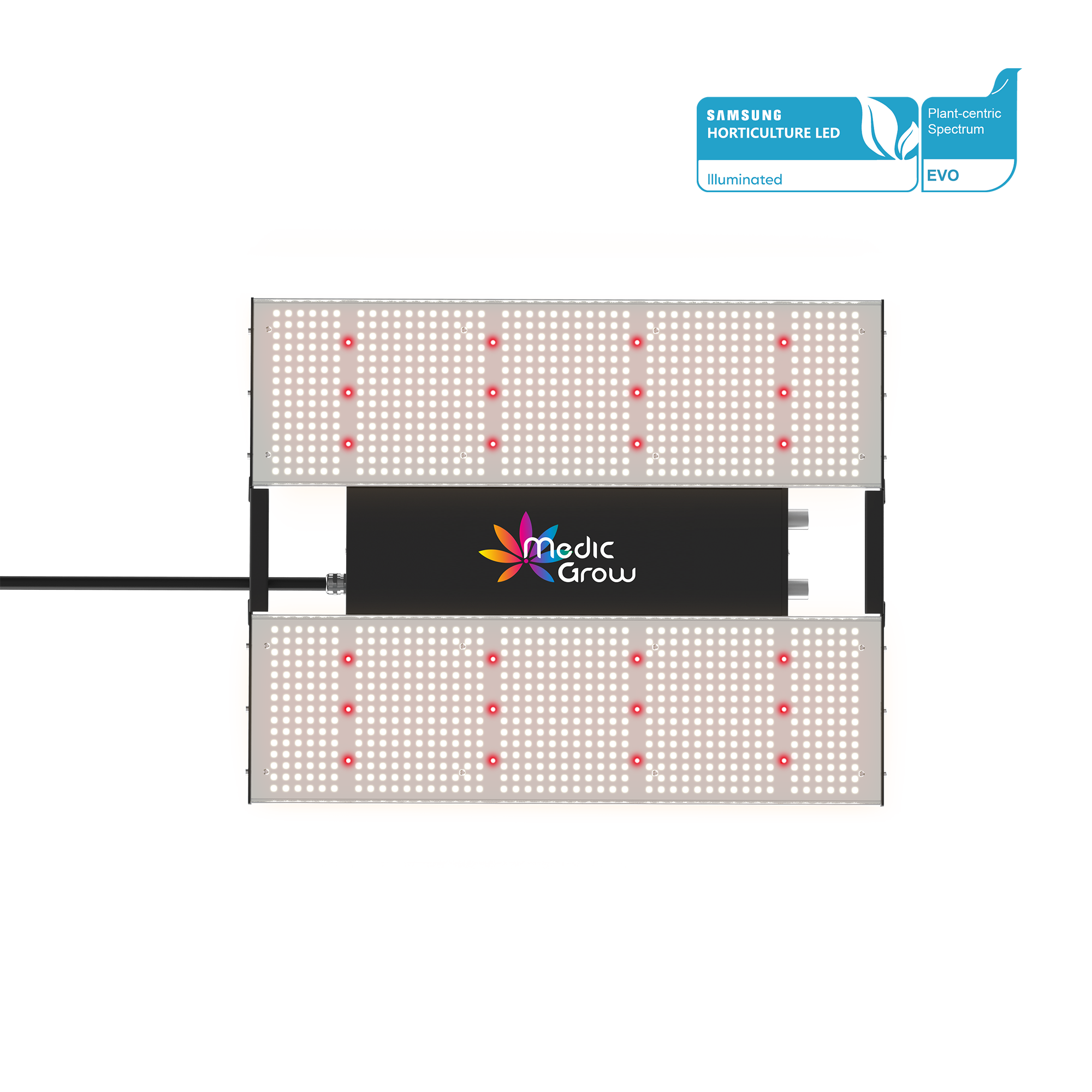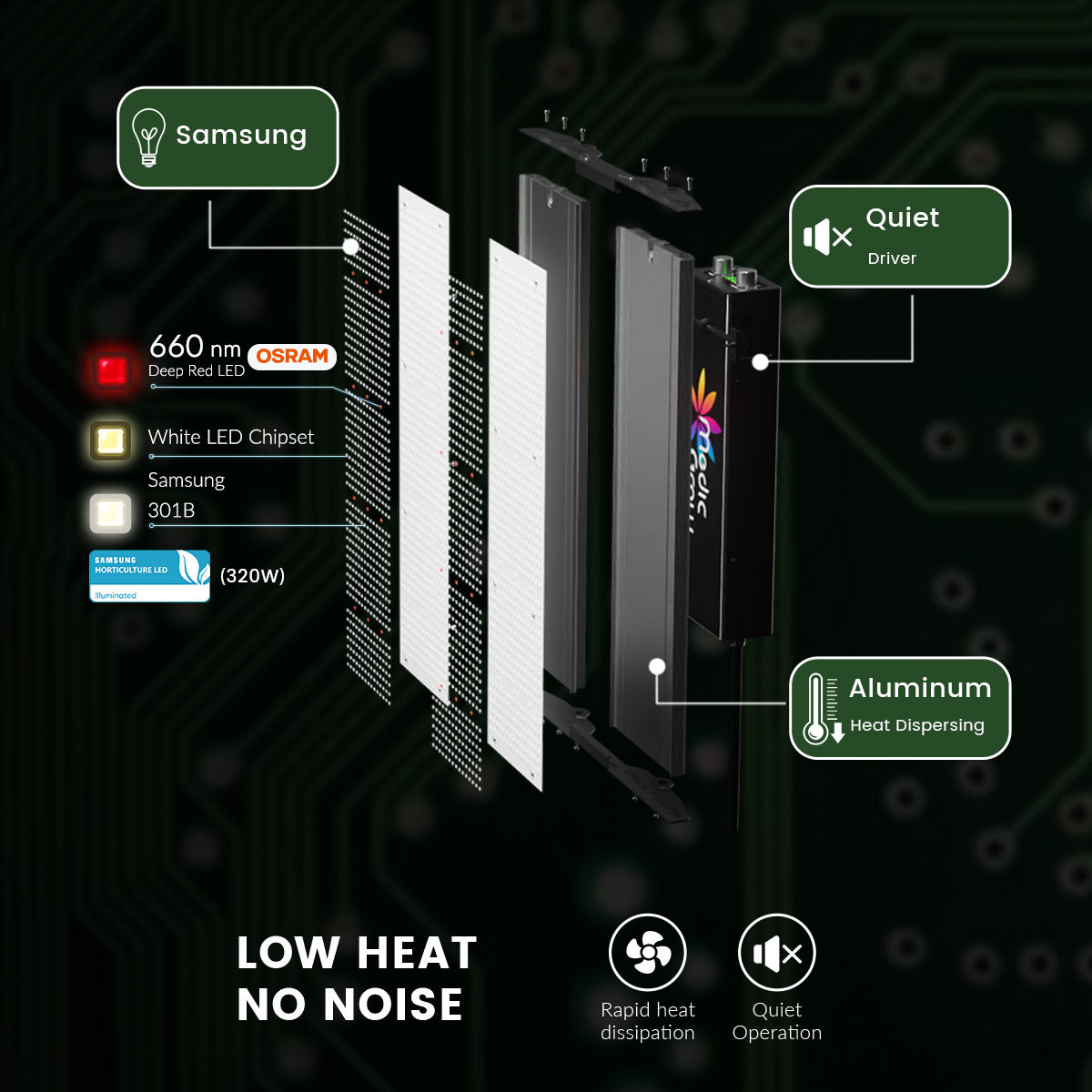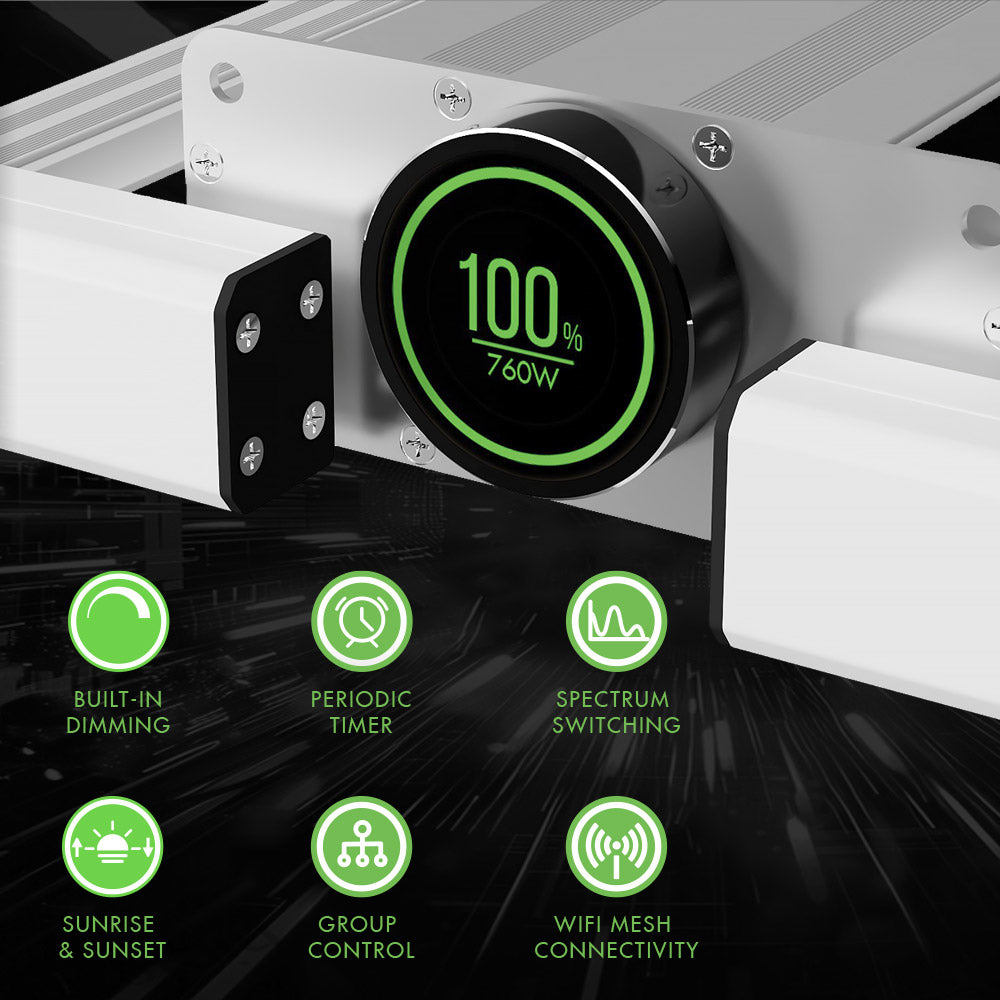
How Does Infrared Light Affect Plant Growth?
Indoor growers are used to growing with grow lights for plants. Some might wonder what infrared light is, what the effect of infrared light on plants is, and whether infrared light is good for their plants.
If it is any good for your plants, then what amount of infrared radiation do they need? Some may also wonder how infrared light is different from UV light.
Infrared light lies between microwaves and visible light, towards the red end of the electromagnetic spectrum.
In this article, we'll discuss everything there is to know about Infrared radiation and the possible benefits of having IR light in your grow room.
We'll explore:
- Part 1: What Is Infrared Light?
- Part 2: How Do Various Grow Lights Use Infrared Light?
- Part 3: Effect Of Infrared Light On Plants
- Part 4: Does Your Grow Room Need Infrared Light For Growing Plants?
- Part 5: Effect Of UV Light On Plants
- Part 6: Things To Keep In Mind When Using Infrared Light For Plants
What Is Infrared Light?
Electromagnetic radiation includes seven kinds of waves, namely:
- 1.Radio Waves
- 2.Microwaves,
- 3.Infrared Rays,
- 4.Visible Light,
- 5.Ultraviolet Rays,
- 6.X-rays, and
- 7.Gamma Rays.
These waves are given different names because of their different sources and different effects on matter.

Image Source: accessscience.com
As per NASA, Infrared waves are waves of the electromagnetic spectrum that lie between microwaves and visible light, in the lower-medium range of frequencies.
When an object is hot, it emits infrared radiation. Even though we cannot see this 'heat' with naked eyes i.e human eyes cannot detect these wavelengths but we can feel it. These waves are not visible to the unaided human eye but one can 'feel' them in the form of warmth.
Instruments such as infrared cameras or night vision goggles can detect this 'heat' from the surroundings and are therefore able to showcase the infrared waves as they are being emitted by objects.
For example, the human body gives off heat but this can only be captured by a special device such as an infrared camera.
These waves can vary in size and can range anywhere from 700 nm to 1 mm.
When these waves fall closer to microwaves, they are more likely to be felt in the form of heat.
The infrared waves that have a longer wavelength produce heat while the infrared rays with a shorter wavelength do not produce much heat.
Infrared waves are used in physical therapy, night vision goggles, infrared lamps, infrared heaters, remote controls, photography, etc.
Whether these waves are absorbed or reflected entirely depends on the nature of the object that these waves hit. For instance, certain materials such as water vapor, stone, wood, may absorb IR while materials such as snow may reflect it.
When objects/bodies get hotter, they emit more infrared radiation than cold objects/bodies. At absolute zero or when an object has no temperature, it doesn't emit any infrared radiation.
Plants don't use infrared light for the process of photosynthesis but infrared light provides warmth to the plants.
Let's dive further into the different wavelengths that make up infrared light:

Image Source: jnhlifestyles.com
●Near-infrared light:
As the name suggests, wavelengths of electromagnetic radiation lying in this bandwidth are the shortest in the full spectrum light. This light is closest to the visible light wavelength range and is used in photography, fiber-optic communication, and remote controls.
●Mid-infrared light:
The wavelengths that fall in this wavelength range are warmer than near-infrared. This is typically used in astronomy by scientists and astronomers.
●Far-infrared light:
The longer wavelengths of radiation that fall in this range are called far-infrared light and are hot. This infrared radiation light is typically found in a grow room.
In the next part, let's take a look at how various grow lights use infrared light.
How Do Various Grow Lights Use Infrared Light?
As discussed in some of our articles before, HID, LED and T5 lights are the three prominent kinds of grow light fixtures that are used for indoor gardening. These lights are capable of providing infrared radiation.
●HID Grow Lights:
HID grow light fixtures are powered by gas and provide heat and light to the plants in the canopy. They are used in labs and indoor growing operations.
HID lamps have gases and metal salts inside and they contain two electrodes. The electricity arcs between the two electrodes and merges with the gas inside the tube.
Some sources claim that about 30 percent of the HID light is infrared radiation.
●LED Grow Lights:
LED grow light fixtures like Medicgrow 1000W grow lights make the use of LED chips that provide high PAR readings. These lights are capable of providing infrared light for growing plants.

●T5 Grow Lights:
T5 grow light fixtures are similar to HIDs in terms of having the same working principle. These lights give off a small amount of infrared light.
In the next part, let's take a quick look at the effect of infrared light on plants.
Effect Of Infrared Light On Plants
Almost all kinds of grow light fixtures produce some heat—this takes the form of Infrared light or Infrared Radiation (IR).
Even though infrared light falls outside of the spectrum of visible light required for photosynthesis, it does provide your plants with heat radiation which in turn encourages plant growth.
Planta claims that an increase in infrared waves can influence stem growth speed. Brief exposure to far-infrared radiation light increased the node spacing.
This happened after the plant was exposed to far-infrared light after 8 hours of light. This suggests that infrared light for growing plants can encourage proper node spacing.
Several researchers claim that infrared light can encourage blooming in plants because of the presence of photoreceptors called phytochromes.
These photoreceptors are crucial for a plant's development and regulate processes such as the expansion of leaves, stem growth, and blooming. As per Texas A&M University, infrared light has a role in the blooming of flowering plants.
Phytochromes have a strong reaction to IR light and being exposed to optimal amounts of it would trick them into thinking that they're receiving the same quantity of light that they would receive outdoors.
Does Your Grow Room Need Infrared Light For Growing Plants?
Whether infrared radiation is suitable for your grow room or not completely depends on the growing conditions.
Different kinds of molecules react differently to various sets of infrared radiation frequencies. Water molecules, in particular, get excited when exposed to infrared radiation at 970 nm, 1200 nm, 1450 nm, 1950 nm, and 3000 nm.
Keeping in mind that the optimal leaf temperature for maximum photosynthesis to occur for most temperate-zone plants is 25-30°C, infrared radiation could come in handy and be useful in raising the temperature in cold grow rooms.
On the contrary, if you're already dealing with high temperatures, then infrared radiation isn't something that's meant for your growing room.
The infrared radiation that is emitted from lighting fixtures has the ability to heat up the leaf temperatures. In an environment like an indoor grow tent kit that is already warm, infrared radiation is not ideal.
Fortunately, plants can regulate their leaf temperature with transpiration. Transpiration almost looks like the leaf is sweating, when in fact, it is regulating its temperature.
Typically, grow lights are used in the winter season or in areas that experience colder climates where it is difficult for plants to get enough sunlight. In such cases, infrared radiation can heat the leaf surface and help increase leaf temperature. This can encourage and speed up plant growth.
When growers don't want to heat up the plant surface too much, LED grow lights can deliver the appropriate amount of light with minimal infrared radiation. LED grow light fixtures are highly efficient and can compete with traditional lighting systems.
Picking a highly efficient grow light is one of the several factors that can alter the temperature in a grow room. Growers can also use fans, thermostats, AC units, auto-dimming features, etc.
Another light that falls on the electromagnetic spectrum is UV light. Let's try to understand what UV light is and how it can be beneficial for your plants.
Effect Of UV Light On Plants
Sunlight naturally contains UV light so all the plants that grow outdoors are exposed to UV light. UV radiation falls between visible light and X rays on the electromagnetic spectrum.
Ultraviolet light or UV light for plants, when used correctly, can be immensely beneficial. It can give your plants a lovely, rich color and increase the taste/flavor. Even though UV light is not an absolute necessity for plants, it does have notable advantages that can improve the quality of crops.

Image Source: ccohs.ca
There are three kinds of UV grow light:
●UVA (320 nm to 400 nm):
UVA has a similar effect on plants as blue light. This can include encouraging the production of anthocyanin, increasing pigmentation, and promoting cell elongation.
●UVB (280 nm to 320 nm):
UVB lights are capable of signaling a stress response in plants. Plants are very sensitive to UVB lights and their response can be seen in the form of increased production of pigments, increased production of antioxidants, and increased production of resin.
The primary benefit of using these lights is that these responses can help enhance flavor in plants.
UVB lights are usually used in the final few weeks of growth. Since these lights can slow down growth, they must be used when plants have grown substantially and when it is time for the plants to develop flavor. UVB lights can be introduced in small amounts/doses.
On several plants, growers can see a visible difference in the resin production after the UVB lights have been introduced. However, it must be noted that each crop is different. Make sure to introduce the light slowly to see how it reacts.
●UVC lights (100 nm to 280 nm):
Probably the most dangerous of the bunch, UVC light is germicidal and has the potential to kill microorganisms. It is used to sanitize surfaces and liquids (e.g. water sterilization).
Growers typically use it in their pipes to sanitize the nutrient solutions or water sources that are being supplied to their plant canopy.
Another application of this light is to kill pathogens in the plant canopy (such as powdery mildew). UVC light has the potential to damage plant DNA which is why these lights must be used with caution — they should strictly be used when growers (as well as their plants) aren't in the growing area or aren't interacting with the light.
Even short-term exposure to the UVC light can be damaging to the plants so, make sure that you are very careful. When using UVC light, growers must wear protective apparel because this light can cause burns or lesions.
Now, let's take a look at some factors that growers should consider when using infrared light for their plants.
Things To Keep In Mind When Using Infrared Light For Plants
●Plants need an optimal grow room temperature while keeping all kinds of heat and light sources balanced. To do this, growers must place their plants strategically to ensure that they get optimal light intensity without having to deal with excess heat.
●Plants that produce heavy fruits and flowers have more biomass to absorb radiant heat. This means that flowering, budding or fruiting plants absorb more infrared radiation as they grow and mature. This can be challenging, particularly in annual species that mature in the fall season when temperatures are getting naturally decreased OR in plants that are sensitive to heat.
●Subjecting your plants to excessive amounts of PAR photons and infrared radiation can cause heat stress in them.
Heat stress affects plants drastically, causing the leaves to curl downwards to preserve moisture, turn brown and become dry. The stomata on leaves close to preserve water and photosynthesis rates get reduced.
Conclusion
So, do you need infrared light for your plants?
The answer is: it depends!
Infrared radiation possesses numerous benefits for plants such as adequate node spacing. IR light can heat the plant surface and subsequently increase leaf temperature. This can promote and increase plant growth.
However, overexposure to infrared light for plants can be damaging.
Most grow lighting systems provide some amounts of IR.
The key is to find the perfect position of your grow lights so that your plants can get adequate light and optimal doses of infrared radiation. Make sure to check the leaf temperature and grow room temperature to make sure that the growing conditions are suitable for your plants.
Related Posts
Do Indoor Plants Need UV Light?
Grow Light vs Regular Light: Can Any LED Light be Used as a Grow Light?
Featured Products
Blog Posts
Contact Us with Any Idea!
- Choosing a selection results in a full page refresh.
!
































